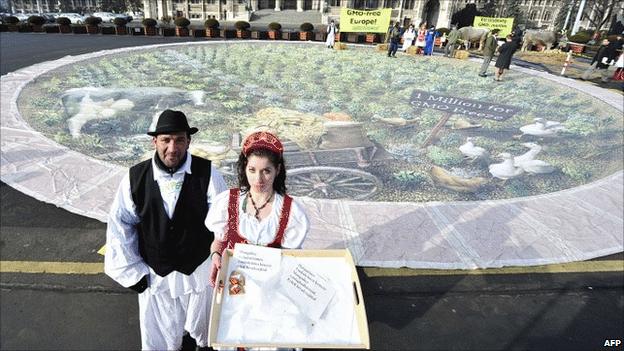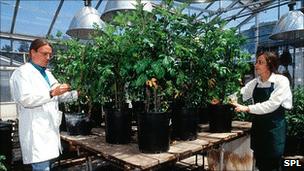GM crops continue spread, passing 'billion hectares'
- Published

Most European societies remain opposed to GM agriculture, despite advances elsewhere
The area of the world's farmland used for growing genetically modified crops increased by about 10% last year.
GM use grew fastest in Brazil but fell in the EU, says the International Service for the Acquisition of Agri-biotech Applications (ISAAA).
Virtually all GM strains used were engineered for just two traits, disease resistance and herbicide tolerance.
ISAAA is an organisation partly funded by industry that promotes biotechnology as a path to sustainability.
It calculates that more than a billion hectares have been cultivated with GM crops since their introduction in 1996 - the figure derived by adding together the areas cultivated with these varieties in all of the intervening years.
'Here to stay'
ISAAA estimates that more than 15 million farmers are involved in GM agriculture.
"We can recount a momentous year of progress in biotech crop adoption," said Clive James, the organisation's chairman and founder.
"During 2010, the accumulated commercial biotech plantation exceeded one billion hectares - that's an area larger than the US or China.
"And biotech crops registered double-digit growth over 2009, bringing the total global plantings to 148 million hectares. Biotech crops are here to stay."
However, critics point out that this is still just 10% of the world's arable land area as defined by the UN Food and Agriculture Organization (FAO).
About half of the global GM total is accounted for by the US - although overall, the developing world is adopting the technology faster than industrialised countries.
If current trends continue, developing countries will be growing more than half of the global total within a few years.

Potatoes are among the GM crops starting to become more widespread
During 2010, Pakistan and Burma took their initial steps into the GM world by growing cotton modified to be resistant to insect pests.
The EU, however, continues to buck the global trend, registering a slight fall in the land area under GM cultivation.
Germany and Sweden both supported small areas of a new potato variety grown not for food, but to produce high-quality starch for industrial use.
Greenpeace, meanwhile, has presented a petition bearing more than a million signatures to the European Commission, demanding that the executive stop approving new GM varieties.
Recently, the EU introduced the "European citizen's initiative", which allows more than a million citizens jointly to ask for a change in the law.
"Today's European data shows that GM crops are failing in the field and on the market; farmers and consumers are not falling for biotech industry propaganda," said Greenpeace EU agriculture policy adviser Stefanie Hundsdorfer.
"GM crops are not more productive and are less resistant to extreme climate conditions than normal crops. They do however present a serious risk for our environment."
Golden future
One of the principal criticisms of the biotech industry down the years is that companies have not commercialised crops that produce direct benefits to the public, such as those with improved nutritional content, or that allow farmers in poor countries to grow crops in land that is currently too hot, too dry or too salty.
Virtually all of the crops grown in 2010 were either engineered to be resistant to insect pests - typically, through insertion of a Bacillus thuringiensis (Bt) gene that produces a toxin - or tolerant to proprietary herbicides.
A significant and growing proportion - about 20% - carried both traits, reflecting the trend for companies to market varieties containing a number of introduced genes "stacked" on top of each other.
Up to eight genes are stacked in a single variety.
Another criticism is that just four crops - soya bean, cotton, maize and canola (a relative of rape) - dominate the market, with little attention paid to other important foods of the developing world poor, such as rice, millet or sorghum.
Dr James suggested this situation was about to change, with crops due to come into commercial use over the next five years, including many with enhanced nutrition, notably "Golden Rice" enhanced in Vitamin A.
"Golden rice is expected to be available in 2013 in the Philippines and thereafter in Bangladesh, Indonesia and Vietnam," he said.
"Also [we will soon see] potatoes modified to resist late blight - the disease that caused the Irish potato famine - as well as sugar cane, bananas, eggplant, tomato, cassava. sweet potato, pulses and groundnuts."
He claimed that the introduction of Golden Rice could save the lives of thousands of people afflicted with Vitamin A deficiency.
- Published13 January 2011
- Published2 December 2010
- Published8 October 2010
- Published6 August 2010